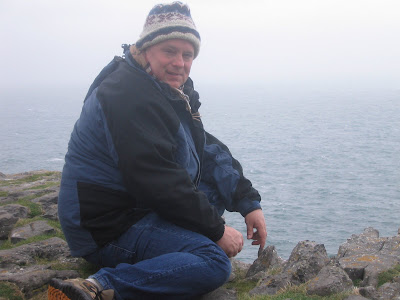19 March 2007
The Aran Islands
The Aran Islands - Inishmore, Inishmaan and Inisheer - are located about 30 miles off the West coast of Ireland. Over St. Patrick's Day weekend we ventured to Inishmore. We took a 2 1/2 hour train ride from Dublin to Galway and then took an hour bus ride north to Roscommon. We then boarded the ferry for a 45 minute (wild) ride. We left Galway Bay with everyone laughing and taking pictures as we bounced and swayed in the huge waves. After about 15 minutes the boat became silent and the crew began quickly handing out plastic bags for the seasick. Luckily, we were fine, but the others didn't enjoy their trip too much. As we disembarked the ferry, our B&B was right at the end of the pier. We were the first guests of the season to check in. The islands are so isolated, that the season runs from St. Patrick's weekend to Halloween. Inishmore is 12 miles long and 3 miles wide and about 800 people live there. They have one mini-mart, two restaurants, and being Ireland...6 pubs! A very unique feature of the Aran Islands is that it is one of the few places in the country where Irish or Gaelic is still spoken.
18 March 2007
St. Patrick's Day
It was fun to be in a small village for St. Patrick's Day. Many of the locals gathered with their families at Ti Joe Watty's Pub. A big rugby match was on from 1-3pm and the parade was scheduled to start after the end of the match. The local school children made hats out of newspaper and decorated them with orange and green streamers. The parade consisted of the fire brigade, the school children, 3 musicians and 1 float. Despite the pouring rain and raging wind, the parade (all 15 minutes of it) walked through town. After the parade, the kids all came back to the pub for games and music. Two teenage boys provided the traditional music while the girls danced. It was really unique experience to celebrate with the locals. Craig and I along with one other couple were the only mainlanders in the place.
17 March 2007
History of the Aran Islands
The earliest ring forts on the island date from the Iron Age (c. 400 BC-500 AD) or even possibly from the Late Bronze Age (c. 700 BC). The limestone pavement and rock formations are incredible. Walking around the island you can imagine the lives of the early inhabitants. Hand built rock walls divide up almost every parcel of land. The tremendous cliffs run the entire length of the island. Farmers continue to bring seaweed up from the beach to lay on the ground to use as compost on the rocky soil. Cows, sheep, chickens and a few people and their dogs are the only things we saw when we hiked around the island. The permanent residents have cars, but mostly people walk, ride bikes, or take pony carts.
16 March 2007
Subscribe to:
Comments (Atom)




















